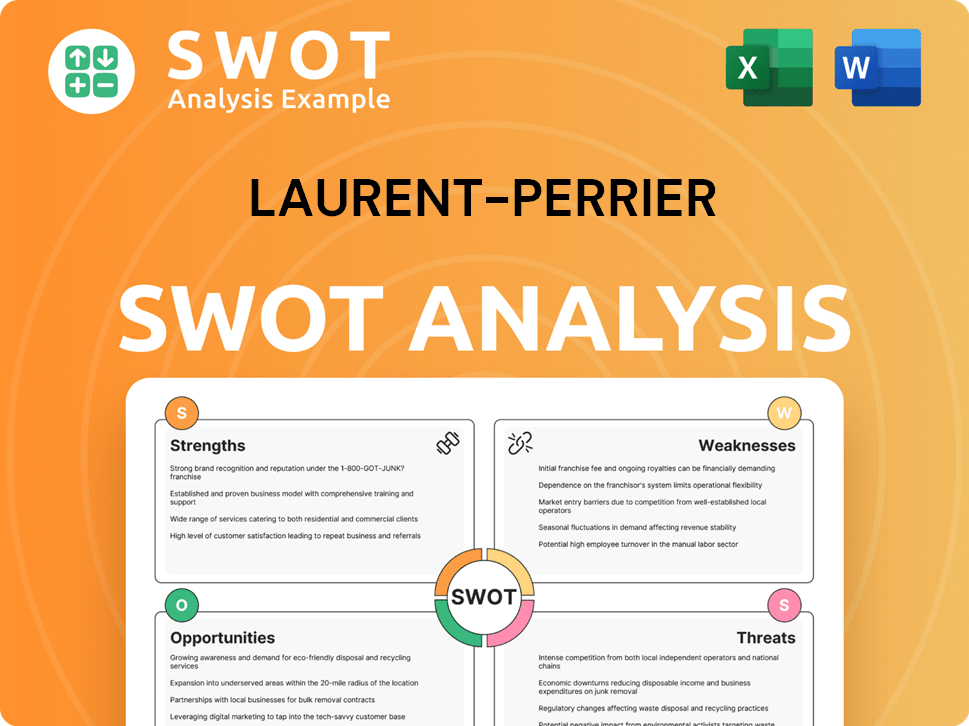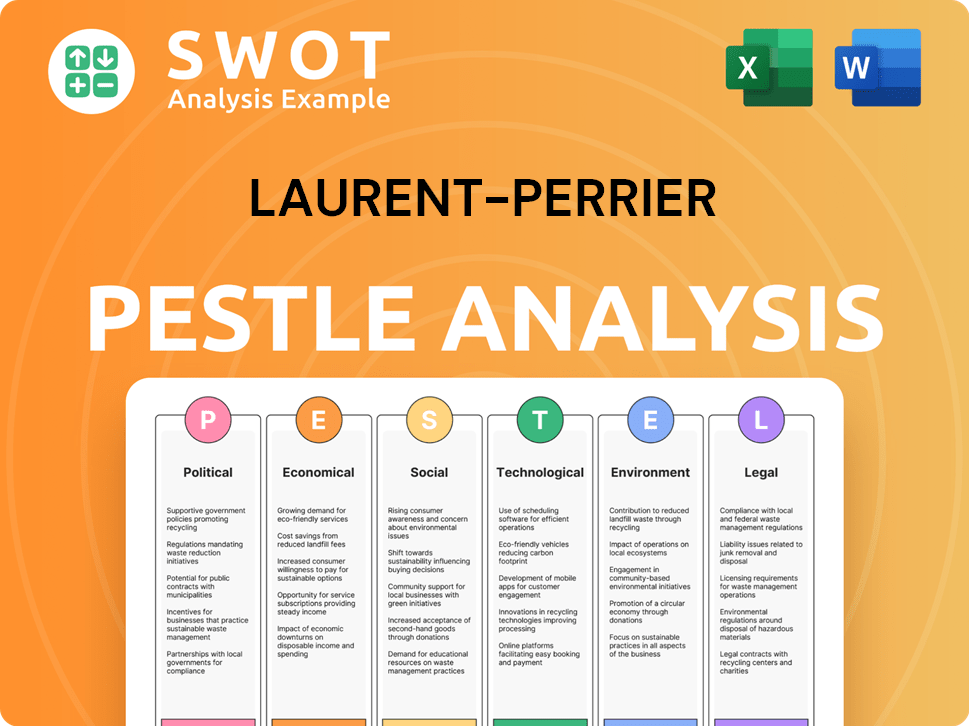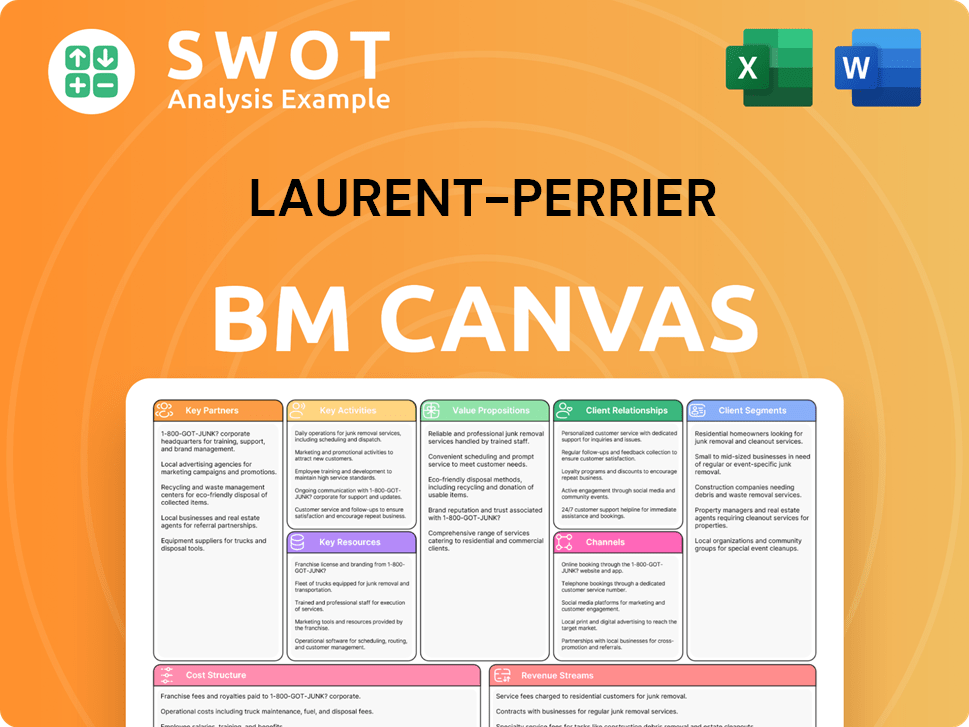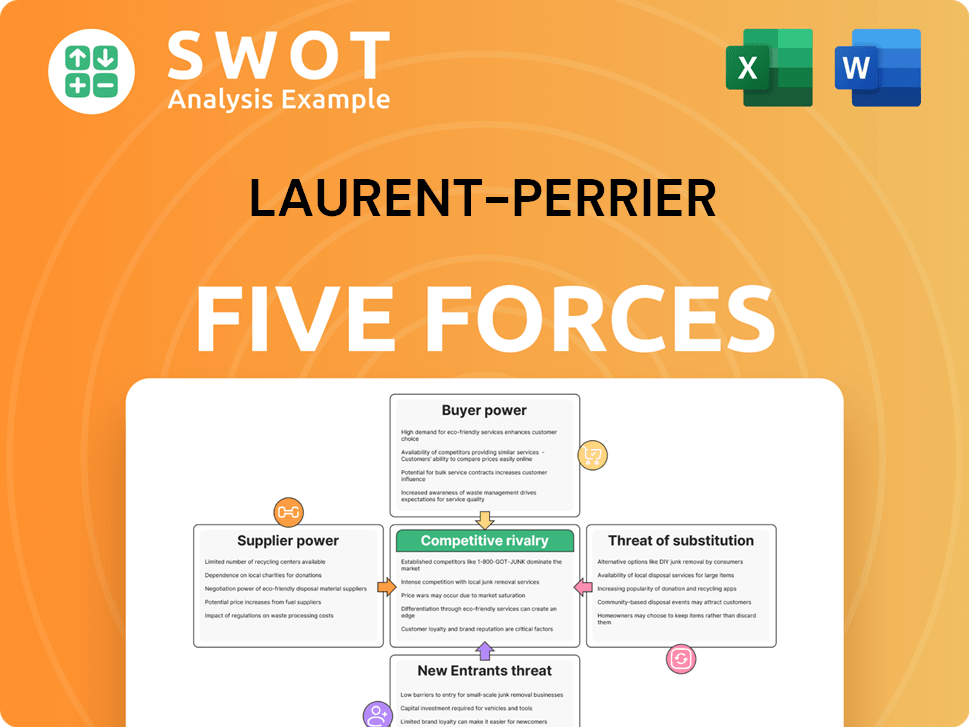Laurent-Perrier Bundle
Who Really Calls the Shots at Laurent-Perrier?
Understanding the Laurent-Perrier SWOT Analysis is crucial, but have you ever wondered who steers the ship of this iconic Champagne house? The ownership structure of a company like Laurent-Perrier is a critical factor, influencing everything from its strategic direction to its market performance. Knowing the key players behind a brand can unlock a deeper understanding of its past, present, and future.

From its humble beginnings in 1812 to its current status as a global Champagne brand, Laurent-Perrier's journey has been marked by fascinating shifts in ownership. This exploration into Laurent Perrier ownership will reveal the key individuals and entities that have shaped the company's destiny, including the influential de Nonancourt family and its current public shareholding structure. Discover the Laurent-Perrier history and the forces that continue to shape this renowned Champagne house.
Who Founded Laurent-Perrier?
The story of Laurent-Perrier, a renowned Champagne house, began in 1812. André-Michel Pierlot, a former cooper and bottler, laid the foundation for what would become a celebrated Champagne brand.
The ownership of Laurent-Perrier has evolved over time, reflecting the changing hands of the Champagne house. From its early beginnings to its current structure, the history of Laurent-Perrier is a testament to the resilience and adaptability of a luxury brand.
Understanding the founders and early ownership provides essential context for appreciating the brand's legacy. This knowledge helps to understand the brand's journey and its evolution within the competitive Champagne market.
André-Michel Pierlot, a cooper and bottler, launched the business in Tours-sur-Marne in 1812. This marked the initial step in the long history of the Laurent-Perrier brand.
Alphonse Pierlot, the son of André-Michel, inherited the company. Without direct descendants, he later transferred the business to his cellar master.
Eugène Laurent, the cellar master, and his wife, Mathilde Emilie Perrier, took control. They combined their names in 1881, renaming the company Laurent-Perrier.
Following Eugène's death in 1887, Mathilde-Emilie Perrier took over. She added 'Veuve' (widow) to the name, expanding the company significantly.
Eugénie-Hortense Laurent inherited the company in 1925. She faced challenges that led to the sale of the business in 1939.
Marie-Louise Lanson de Nonancourt acquired the company in 1939. This marked the beginning of the de Nonancourt family's long-term ownership.
The ownership of Laurent-Perrier has seen several key transitions, each shaping the brand's trajectory. From its humble beginnings with André-Michel Pierlot to the enduring influence of the de Nonancourt family, the Champagne house has navigated various stages of ownership. The brand's history is intertwined with the families who have guided it.
- André-Michel Pierlot founded the business in 1812.
- Eugène Laurent and Mathilde Emilie Perrier renamed the company in 1881.
- Mathilde-Emilie Perrier expanded production to around 600,000 bottles by the late 19th century.
- Marie-Louise Lanson de Nonancourt acquired the company in 1939, beginning the de Nonancourt family's ownership.
- The de Nonancourt family continues to be a significant part of the Laurent-Perrier story. For more details on how the company operates, check out the Revenue Streams & Business Model of Laurent-Perrier.
Laurent-Perrier SWOT Analysis
- Complete SWOT Breakdown
- Fully Customizable
- Editable in Excel & Word
- Professional Formatting
- Investor-Ready Format

How Has Laurent-Perrier’s Ownership Changed Over Time?
The ownership of the Champagne house, Laurent-Perrier, is rooted in a rich history, starting with Marie-Louise Lanson de Nonancourt's acquisition in 1939. This pivotal moment established a family legacy that would shape the company's future. Her youngest son, Bernard de Nonancourt, took over in 1949, playing a key role in Laurent-Perrier's expansion. Under his leadership, the brand grew significantly, moving from the 100th position to become the third best-selling Champagne brand globally by volume.
The evolution of Laurent-Perrier's ownership structure is a blend of family control and public market participation. The company went public in 1999, but the de Nonancourt family has maintained a significant stake, ensuring a long-term vision. This approach has allowed the company to focus on quality and brand building over immediate financial gains. The current ownership structure reflects a balance between family influence and institutional investment.
| Key Event | Year | Impact |
|---|---|---|
| Marie-Louise Lanson de Nonancourt's Acquisition | 1939 | Established family ownership and legacy. |
| Bernard de Nonancourt Takes Over | 1949 | Led to significant growth and expansion. |
| Initial Public Offering (IPO) | 1999 | Brought the company to the public market, while maintaining family control. |
Laurent-Perrier is a public company listed on the Euronext Paris stock exchange (Ticker Symbol: LPE). As of February 2024, the de Nonancourt family held a substantial stake, owning approximately 65% of the company. This strong family presence ensures a focus on long-term strategy. Beyond the family, institutional investors play a significant role. First Eagle Investments is the largest outside owner, holding around 9% of the outstanding shares and 5% of the voting rights as of May 2024. Other institutional investors include FIL Limited (2.5% of capital and voting rights), DNCA Finance Luxembourg (2% of capital), and AXA Investment Managers SA (1% of capital and 0.5% of voting rights). For the 2024-2025 financial year, ending March 31, 2025, Laurent-Perrier reported a consolidated turnover of €282.9 million. To learn more about the brand's growth, check out the Growth Strategy of Laurent-Perrier.
Laurent-Perrier's ownership is primarily controlled by the de Nonancourt family, who hold a significant stake in the company.
- The company went public in 1999, but the family retained a majority of the shares.
- First Eagle Investments is a major institutional investor.
- The company's market capitalization was $669 million as of June 11, 2025.
- Laurent-Perrier reported a consolidated turnover of €282.9 million for the 2024-2025 financial year.
Laurent-Perrier PESTLE Analysis
- Covers All 6 PESTLE Categories
- No Research Needed – Save Hours of Work
- Built by Experts, Trusted by Consultants
- Instant Download, Ready to Use
- 100% Editable, Fully Customizable

Who Sits on Laurent-Perrier’s Board?
The governance of the Champagne house, Laurent-Perrier, is structured around a Management Board and a Supervisory Board. This structure, common in French publicly listed companies, separates executive functions from oversight. As of July 2024, the Supervisory Board consists of eight members, with Patrick Thomas as the Non-executive Chairman, a position he has held since April 2021. Marie Cheval serves as Vice-Chairwoman.
The Supervisory Board also includes Jean-Marie Barillère, Yann Duchesne, Philippe-Loïc Jacob, Eric Meneux, Lucie Pereyre, and Jocelyne Vassoille. The Management Board is led by Stéphane Dalyac. Alexandra Pereyre de Nonancourt and Stéphanie Meneux de Nonancourt, daughters of the late Bernard de Nonancourt, act as co-CEOs and members of the Management Board. Lucie Pereyre de Nonancourt, Alexandra's daughter, has also joined the company, ensuring the family's continued involvement. This structure highlights the influence of the de Nonancourt family, who held a significant ownership stake of 65% as of February 2024.
| Board Role | Name | Title |
|---|---|---|
| Non-executive Chairman | Patrick Thomas | Supervisory Board |
| Vice-Chairwoman | Marie Cheval | Supervisory Board |
| Member | Jean-Marie Barillère | Supervisory Board |
| Member | Yann Duchesne | Supervisory Board |
| Member | Philippe-Loïc Jacob | Supervisory Board |
| Member | Eric Meneux | Supervisory Board |
| Member | Lucie Pereyre | Supervisory Board |
| Member | Jocelyne Vassoille | Supervisory Board |
| Chairman | Stéphane Dalyac | Management Board |
| General Manager | Alexandra Pereyre de Nonancourt | Management Board |
| General Manager | Stéphanie Meneux de Nonancourt | Management Board |
The voting structure at Laurent-Perrier generally follows a one-share-one-vote principle. However, the substantial family ownership of the Champagne brand, which is a key aspect of Growth Strategy of Laurent-Perrier, grants them considerable influence over strategic decisions and board member elections. The annual general meeting is scheduled for July 10, 2025, providing a key opportunity for shareholders to influence the company's direction.
The de Nonancourt family maintains significant control of Laurent-Perrier.
- The Supervisory Board oversees the company's operations.
- Stéphane Dalyac chairs the Management Board.
- Alexandra Pereyre de Nonancourt and Stéphanie Meneux de Nonancourt are co-CEOs.
- Family ownership is a major factor in the company's strategic direction.
Laurent-Perrier Business Model Canvas
- Complete 9-Block Business Model Canvas
- Effortlessly Communicate Your Business Strategy
- Investor-Ready BMC Format
- 100% Editable and Customizable
- Clear and Structured Layout

What Recent Changes Have Shaped Laurent-Perrier’s Ownership Landscape?
Over the past few years, the Laurent-Perrier company, a distinguished Champagne house, has maintained its family-owned status. As of February 2024, the de Nonancourt family holds a significant 65% ownership stake. This enduring family control sets Laurent Perrier ownership apart from many other publicly traded companies, highlighting its commitment to tradition and independence within the competitive Champagne brand market. The company's structure is a key aspect of its identity and strategy.
Financially, Laurent-Perrier experienced a downturn in the first half of the 2024-2025 fiscal year (April 1 to September 30, 2024). Champagne sales were at €128.8 million, a 16.0% decrease compared to the previous year, and net profit (Group share) fell by 34.5% to €25.3 million. For the full financial year ending March 31, 2025, revenue from Champagne sales decreased by 6.8% to €282.9 million. Operating profit also declined to €74.4 million, a 21.8% decrease from the record performance in 2023-2024. Despite these challenges, Laurent-Perrier focuses on maintaining a high operating margin and a robust financial structure, with shareholders' equity at €627.3 million and a gearing ratio of 0.35 as of March 31, 2025.
| Metric | 2023-2024 | 2024-2025 |
|---|---|---|
| Champagne Sales (EUR millions) | €303.5 | €282.9 |
| Operating Profit (EUR millions) | €95.1 | €74.4 |
| Net Profit (Group Share) (EUR millions) | N/A | €25.3 (H1) |
| Shareholders' Equity (EUR millions) | N/A | €627.3 |
| Gearing Ratio | N/A | 0.35 |
Industry trends indicate a shift towards value over volume in the champagne market, particularly in key export regions such as the UK. Laurent-Perrier continues to invest in the quality of its wines, its personnel, and global brand support. The company has also established new partnerships, such as with Condé Nast Traveller for their New Restaurant Awards in 2025, demonstrating ongoing marketing and distribution efforts. There have been no public announcements regarding potential privatization or further public listings. This suggests that the de Nonancourt family intends to retain its controlling interest, maintaining the unique aspects of Laurent Perrier ownership for the foreseeable future. To understand their consumer base, you can read about the Target Market of Laurent-Perrier.
The de Nonancourt family, holding approximately 65% ownership as of February 2024, primarily owns Laurent-Perrier. This family control distinguishes the company.
For the financial year ending March 31, 2025, revenue from Champagne sales decreased by 6.8% to €282.9 million, with operating profit at €74.4 million.
The champagne market is focusing on value over volume. Laurent-Perrier is adapting by investing in quality and brand support.
There are no indications of privatization or further public listings, suggesting the de Nonancourt family intends to maintain its controlling stake.
Laurent-Perrier Porter's Five Forces Analysis
- Covers All 5 Competitive Forces in Detail
- Structured for Consultants, Students, and Founders
- 100% Editable in Microsoft Word & Excel
- Instant Digital Download – Use Immediately
- Compatible with Mac & PC – Fully Unlocked

Related Blogs
- What are Mission Vision & Core Values of Laurent-Perrier Company?
- What is Competitive Landscape of Laurent-Perrier Company?
- What is Growth Strategy and Future Prospects of Laurent-Perrier Company?
- How Does Laurent-Perrier Company Work?
- What is Sales and Marketing Strategy of Laurent-Perrier Company?
- What is Brief History of Laurent-Perrier Company?
- What is Customer Demographics and Target Market of Laurent-Perrier Company?
Disclaimer
All information, articles, and product details provided on this website are for general informational and educational purposes only. We do not claim any ownership over, nor do we intend to infringe upon, any trademarks, copyrights, logos, brand names, or other intellectual property mentioned or depicted on this site. Such intellectual property remains the property of its respective owners, and any references here are made solely for identification or informational purposes, without implying any affiliation, endorsement, or partnership.
We make no representations or warranties, express or implied, regarding the accuracy, completeness, or suitability of any content or products presented. Nothing on this website should be construed as legal, tax, investment, financial, medical, or other professional advice. In addition, no part of this site—including articles or product references—constitutes a solicitation, recommendation, endorsement, advertisement, or offer to buy or sell any securities, franchises, or other financial instruments, particularly in jurisdictions where such activity would be unlawful.
All content is of a general nature and may not address the specific circumstances of any individual or entity. It is not a substitute for professional advice or services. Any actions you take based on the information provided here are strictly at your own risk. You accept full responsibility for any decisions or outcomes arising from your use of this website and agree to release us from any liability in connection with your use of, or reliance upon, the content or products found herein.